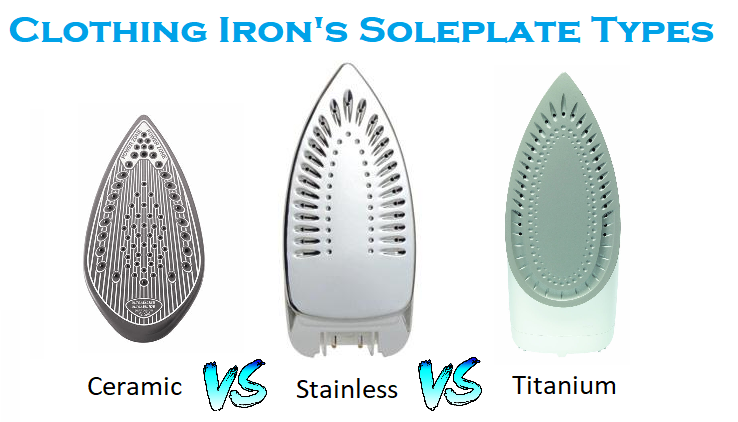 Image Credit: IronsExpert.com
Image Credit: IronsExpert.com
SOLEPLATE IRON MEANING
The clothes iron is an essential device at home. We use it to press our clothes after cloth laundry. It helps to straighten the clothes and remove creases. Aside from the heating elements and thermostats that heat and regulate the temperature of the clothes iron the most important part of the pressing iron is the soleplate.
The iron soleplate is that part of the clothes iron that comes in contact with the clothes during ironing of clothes. It is the bottom or downside of the iron. We can as well define a soleplate as an iron?s underside that when it conducts heat enough can be used to straighten a cloth. It must have a flat and straight surface to perform this function. It can be somehow triangular with a flat surface. It must be spotless always. It is a part of the iron that people look after all the time. It?s a quality that makes the clothes iron superior and highly valued.
TYPES OF IRON SOLEPLATES
There are different types of clothing iron?s soleplates. The types differ mainly due to the material they used in making them. Clothing iron?s soleplate types are ceramic, stainless, titanium, non-stick, steam iron, and cast iron models. The commonest among all is the stainless steel soleplates. They are the ones most available in the market. We look at the different types comparing them to see which will give a much more efficient performance and are cheaper to use in making pressing irons.
CERAMIC OR STAINLESS STEEL IRON PLATE
Ceramic sole plates are plates made of aluminum or plastic with ceramic coating. Such type of sole plates will have a metal plate with a ceramic material overlaid on it, or plastic soleplate and are known as ceramic soleplates. Ceramic is a material from clay and when fired will become hard and brittle.
The ceramic layer placed onto the plate of the clothes iron. On the other hand, a soleplate of stainless steel consists of stainless steel plate. Stainless steel is an alloy of steel made up of at least 10.5% chromium and steel. It?s referred to as inox meaning inoxidizable steel. Each of the plates exhibits the characteristics of their parent material.
For ceramic sole plates they have the following features or benefits:
1. Has a good heat conducting capability2. They distribute the heat evenly3. They prevent or eliminates statics4. They prevent clothes from sticking on to the surface at higher temperatures
For stainless steel soleplate:
i. They are durable.ii. They are good conductors of heat.iii. They have cleaner surfaces that are easy to maintain. iv. They allow even distribution of heat
Some disadvantages of the two surfaces are that ceramic sole plates wear or peel with time while the stainless steel plates cause sticking of glues or decals on the surface at higher temperatures. Both have the limitation that they can melt silk or light-weighted materials at high temperatures.
CERAMIC VS TITANIUM SOLEPLATE
The ceramic sole plates as described above have the following features or benefits:
1. Has good heat conducting capacity2. Distributes the heat evenly3. Prevents or eliminate statics4. Stops gumming of materials to the surface at higher temperatures
Meanwhile, titanium sole plates made from titanium, usually alloyed with aluminum or iron, possess the following characteristic features:
a. A corrosion resistant surface. b. A fast transfer of heat. c. Shiny surfaces that are easy to maintain or cleaned.d. An even transfer of heat e. Very durable and lightweight
Already we have seen the disadvantage of ceramic soleplate as wearing away or peeling with time, producing sticky surfaces when ironing light-weighted materials. The titanium surfaces, when used for any material, will not cause them to stick to it. They transmit heat faster than other materials and are lighter in weight than ceramic or stainless steel soleplates.
The only disadvantage of titanium soleplate is care should be taken so that it does not burn or condemn the cloth due to overheating of a particular surface. It can melt the material.
STAINLESS STEEL SOLEPLATE IRON
Stainless steel an alloy metal of iron and chromium is a useful material in making soleplates. The desirable qualities are as follows:
a. It conducts heat very well.b. It helps in making cheap clothes irons.c. Evenly distributes heat while ironing clothes.d. Possesses a clean surface that is easy to maintain.e. They are the commonest type of sole plates in use.f. They are corrosion resistant therefore do not rust and stain clothes.
As stated earlier, new irons mostly are made of a plastic upper body with sole plates made of stainless steel. The biggest problem the stainless steel sole plates will have over time is an accumulation of materials that become sticky and transfer of dirt to clean clothing when you press them. These occur mostly with the accumulation of starch. To prevent this from becoming a major issue cleaning the soleplate always is necessary.
Related to read: How to Clean Steam Iron
To actualize that do the following:
1. You can scrape with a steel wood when an iron surface is cold2. Use a wool dipped in a mixture of vinegar and water to clean the surface3. Then use a hot iron cleaner to clean the pressing iron surface4. You can press the hot iron on a clean rag to ensure all the sticky materials remaining have disappeared.
NON-STICK SOLEPLATE IRON
These are clothes iron with sole plates coated with nonstick materials to minimize sticking while ironing clothes. The soleplate can be made of any material but is then coated with a nonstick material to make it non-stick soleplate. Materials such as polytetrafluoroethylene (PTFE) like Teflon, anodized aluminum coating, silicone coating, enameled iron coating, etc., can be used for the coating.
They usually produce less sticky soleplate surfaces while ironing clothes. They are good as the covers are very easy to maintain and clean by applying little cleaning agent and wiping with a clean rag.
They have the following advantages :1. Do not cause the stain to your clothes while ironing2. Even distribution of heat3. They are very durable
The primary limitation is that the coating can degrade with time and peel off.
CAST IRON AND STEAM IRON SOLEPLATES
We can also look at cast iron and steam iron sole plates; the cast iron sole plates are outdated and associated with so many issues. They are familiar with the old irons that are not electric irons.
Also, the steam iron plates can incorporate into all the other sole plates mentioned above. They are mainly for wetting the clothes to give better ironing effects as the water or steam softens the fiber of the clothes during ironing. It also aids cooling during ironing. The steam or water droplets get out under the iron surface through perforations underneath the pressing iron on the surface.
This article was brought to you by IronsExpert.


